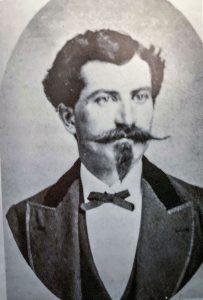Beer, bloodletting and a mysterious disappearance

Julius Seidensticker, taken in Albany, 1867.
We all have life stories, hardships among them. That of the early Seidensticker family of Lake Gulch was a whopper…
George was born in early 1800 in Bavaria, Germany’s Catholic state. His first wife Marie died young, having first delivered Eduard and then little Marie into their world. Though bereaved, George, as much out of necessity as love, married again, this time to Eva. Three more sons, Adolph, William and Julius joined the family. All but Eduard were immigrants to America, filtering into Douglas County in 1867.
The first Seidensticker man arrived on a wagon hitched to a team of oxen. Early enough to claim prime land in Denver City, Adolph first eyed and then passed on a golden opportunity to own a chunk of today’s Capitol Hill area. Being Bavarian and thus a mountain lover, Adolph moved south to Willow Creek off Lake Gulch Road in Castle Rock. According to family lore, the views from those high bluffs, reminiscent of Adolph’s boyhood in the Bavarian Alps, sold him.
By the time Adolph staked his claim and built his cabin, brother William arrived from the old country. Though late to the party, 22-year-old youngest brother Julius finally immigrated in 1867. Migrating first to Albany, New York, he tired quickly of the densely populated east and pivoted west. He took a Union Pacific train to Cheyenne, joining his brothers after a difficult oxcart trip south.
Now together again, the brothers ratcheted up their focus, finances and effort by claiming, and then working, more adjoining Lake Gulch homestead parcels. For their time, they managed the parcels brilliantly in a corporate concept. But things changed. Adolph, apparently acting on a recommendation made in a letter from half-brother Eduard, decided to find himself a business.
After transferring the ranch temporarily to outside management, and following Adolph’s lead, the Seidenstickers got into brewing, Bavarian style. First Adolph bought a brewery in Cheyenne. Then, after persuading his younger brothers, convincing them dreams could come true, he rallied them to Silver Cliff in the Wet Mountains. There, they opened another brewery. Silver fever reigned supreme there in the 1870s with money and opportunities running hot for several years. But the boom-to-bust cycle was a short one, and with another life waiting in reserve, Adolph and Julius returned to Douglas County to resuscitate their ranching futures.
Meanwhile, mother Eva’s health was rapidly fading back in Germany, so Julius crossed the Atlantic twice more to bring her back to Colorado. Simultaneously, Adolph put his chaps and boots back on and concentrated on reinvigorating the family ranch.
Later, out of the blue, William received an SOS letter in Silver Cliff hinting that the ranch “was not prospering.” William rushed home only to find that Adolph had disappeared. When last seen, Adolph was known to be carrying a wad of cash. Locals scoured the countryside, but he was the man who never returned …
The family brewery era ended, and the surviving brothers concentrated on ranching, once again growing their land to nearly 7,000 acres. Julius married another Bavarian, Kate Bauer, in 1883. Fate was not yet done with the Seidenstickers as Kate took deathly ill in 1887. Though pulling out all the stops, including bloodletting efforts and even witchcraft, Kate died at a mere 22 years old.